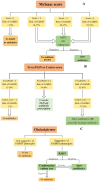Acute pharyngitis in children and adults: descriptive comparison of current recommendations from national and international guidelines and future perspectives
- PMID: 37819417
- PMCID: PMC10746578
- DOI: 10.1007/s00431-023-05211-w
Acute pharyngitis in children and adults: descriptive comparison of current recommendations from national and international guidelines and future perspectives
Abstract
This study aims to provide a comparison of the current recommendations about the management of acute pharyngitis. A literature search was conducted from January 2009 to 2023. Documents reporting recommendations on the management of acute pharyngitis were included, pertinent data were extracted, and a descriptive comparison of the different recommendations was performed. The quality of guidelines was assessed through the AGREE II instrument. Nineteen guidelines were included, and an overall moderate quality was found. Three groups can be distinguished: one group supports the antibiotic treatment of group A β-hemolytic Streptococcus (GABHS) to prevent acute rheumatic fever (ARF); the second considers acute pharyngitis a self-resolving disease, recommending antibiotics only in selected cases; the third group recognizes a different strategy according to the ARF risk in each patient. An antibiotic course of 10 days is recommended if the prevention of ARF is the primary goal; conversely, some guidelines suggest a course of 5-7 days, assuming the symptomatic cure is the goal of treatment. Penicillin V and amoxicillin are the first-line options. In the case of penicillin allergy, first-generation cephalosporins are a suitable choice. In the case of beta-lactam allergy, clindamycin or macrolides could be considered according to local resistance rates. Conclusion: Several divergencies in the management of acute pharyngitis were raised among guidelines (GLs) from different countries, both in the diagnostic and therapeutic approach, allowing the distinction of 3 different strategies. Since GABHS pharyngitis could affect the global burden of GABHS disease, it is advisable to define a shared strategy worldwide. It could be interesting to investigate the following issues further: cost-effectiveness analysis of diagnostic strategies in different healthcare systems; local genomic epidemiology of GABHS infection and its complications; the impact of antibiotic treatment of GABHS pharyngitis on its complications and invasive GABHS infections; the role of GABHS vaccines as a prophylactic measure. The related results could aid the development of future recommendations. What is Known: • GABHS disease spectrum ranges from superficial to invasive infections and toxin-mediated diseases. • GABHS accounts for about 25% of sore throat in children and its management is a matter of debate. What is New: • Three strategies can be distinguished among current GLs: antibiotic therapy to prevent ARF, antibiotics only in complicated cases, and a tailored strategy according to the individual ARF risk. • The impact of antibiotic treatment of GABHS pharyngitis on its sequelae still is the main point of divergence; further studies are needed to achieve a global shared strategy.
Keywords: GABHS; GAS; Group A β-hemolytic streptococcus; Pharyngitis; Sore throat; Streptococcus pyogenes.
© 2023. The Author(s).
Conflict of interest statement
Authors declare no relevant financial or non-financial interests
Figures
References
Publication types
MeSH terms
Substances
LinkOut - more resources
Full Text Sources
Medical
Miscellaneous



